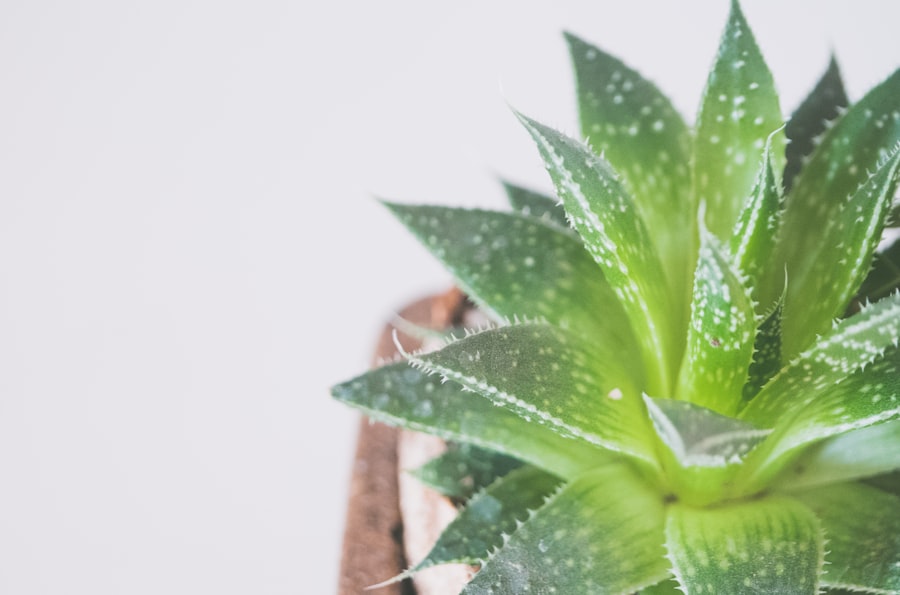Laser hair removal is a popular cosmetic procedure that utilizes concentrated beams of light to target and eliminate unwanted hair. The process works by emitting a specific wavelength of light that is absorbed by the pigment in the hair follicles. This absorption generates heat, which effectively damages the follicles and inhibits future hair growth.
As you consider this treatment, it’s essential to understand that it is most effective on individuals with light skin and dark hair, as the contrast allows the laser to target the hair more efficiently. During your initial consultation, a trained professional will assess your skin type, hair color, and medical history to determine if you are a suitable candidate for laser hair removal. They will explain the procedure in detail, including the number of sessions you may need for optimal results.
Typically, multiple sessions are required because hair grows in cycles, and the laser is most effective during the active growth phase. Understanding this process will help you set realistic expectations and prepare for the journey ahead.
Key Takeaways
- Laser hair removal targets hair follicles with concentrated light to inhibit future hair growth
- Shave the treatment area before the appointment and avoid sun exposure and tanning beds
- Apply soothing creams and cool compresses to alleviate discomfort and irritation after treatment
- Use sunscreen and protective clothing to shield the treated area from sun exposure
- Avoid hot showers, saunas, and certain skincare products to prevent irritation and complications
Preparing for Laser Hair Removal Treatment
Preparation is key to ensuring a successful laser hair removal experience. Before your first appointment, you should avoid sun exposure for at least four weeks. Tanning can increase the risk of complications and reduce the effectiveness of the treatment.
If you have recently tanned or have a sunburn, it’s advisable to reschedule your appointment until your skin has returned to its normal tone. Additionally, you should refrain from waxing or plucking hair in the treatment area for several weeks prior to your session, as these methods can remove the hair follicle that the laser targets. On the day of your treatment, arrive with clean skin free from lotions, creams, or makeup.
Your technician may provide you with protective eyewear to shield your eyes from the laser light. Depending on your pain tolerance and the area being treated, a topical anesthetic may be applied to minimize discomfort during the procedure. Being well-prepared not only enhances your comfort but also maximizes the effectiveness of the treatment.
Post-Treatment Care Instructions
After undergoing laser hair removal, it’s crucial to follow post-treatment care instructions to ensure optimal healing and results. Initially, you may experience some redness and swelling in the treated area, similar to a mild sunburn. Applying a cool compress can help alleviate discomfort and reduce inflammation.
It’s important to avoid hot showers, saunas, or intense workouts for at least 24 hours post-treatment, as these can exacerbate irritation.
Use a gentle cleanser and apply a soothing lotion or aloe vera gel to promote healing. Avoid using harsh scrubs or exfoliants for at least a week following your session. By adhering to these care instructions, you can help ensure that your skin heals properly and that you achieve the best possible results from your laser hair removal treatment.
Managing Discomfort and Irritation
| Technique | Effectiveness | Notes |
|---|---|---|
| Deep Breathing | High | Helps to relax and reduce tension |
| Progressive Muscle Relaxation | Medium | Can help to release physical tension |
| Mindfulness Meditation | High | Can increase awareness and reduce stress |
| Positive Self-talk | Low | May not work for everyone, but can be helpful for some |
While many people tolerate laser hair removal well, some may experience discomfort during and after the procedure. If you find yourself feeling anxious about potential pain, it’s helpful to discuss this with your technician beforehand. They can provide reassurance and may suggest additional pain management options, such as applying ice packs or using numbing creams before treatment.
If you do experience irritation after your session, over-the-counter pain relievers like ibuprofen can help alleviate discomfort. However, be cautious with any medications and consult with your provider if you have any concerns. Additionally, if you notice any unusual symptoms such as excessive swelling, blistering, or signs of infection, it’s essential to contact your healthcare provider promptly for guidance.
Protecting the Skin from Sun Exposure
One of the most critical aspects of post-laser hair removal care is protecting your skin from sun exposure. After treatment, your skin will be more sensitive and vulnerable to UV rays. To minimize the risk of pigmentation changes or sunburn, it’s advisable to apply a broad-spectrum sunscreen with an SPF of 30 or higher whenever you go outside.
Reapply every two hours, especially if you are sweating or swimming. In addition to sunscreen, wearing protective clothing such as hats or long sleeves can further shield your skin from harmful rays. If possible, try to avoid direct sunlight during peak hours when UV radiation is strongest.
By taking these precautions seriously, you can help maintain your skin’s health and enhance the results of your laser hair removal treatment.
Avoiding Certain Activities and Products

In the days following your laser hair removal session, there are specific activities and products you should avoid to ensure proper healing. For instance, refrain from engaging in strenuous exercise or activities that cause excessive sweating for at least 48 hours post-treatment. This is important because sweat can irritate the treated area and increase the risk of complications.
Additionally, be cautious with skincare products during this time. Avoid using retinoids, glycolic acid, or any harsh exfoliants for at least a week after treatment. These ingredients can irritate sensitive skin and hinder the healing process.
Instead, opt for gentle cleansers and moisturizers that are free from fragrances and dyes. By being mindful of your activities and product choices, you can support your skin’s recovery and achieve better results.
Monitoring and Maintaining Results
Once you’ve completed your laser hair removal sessions, it’s essential to monitor your results over time. While many individuals experience significant hair reduction after their initial treatments, some may notice fine hairs regrowing in certain areas. This is normal and can be addressed with maintenance sessions as needed.
Typically, maintenance treatments are recommended every six months to a year, depending on individual hair growth patterns. Keeping track of your progress will help you determine when it’s time for a touch-up session. If you notice any changes in hair growth or have concerns about your results, don’t hesitate to reach out to your provider for advice.
They can assess your situation and recommend an appropriate course of action to ensure that you maintain smooth skin long-term.
Follow-up Appointments and Additional Treatments
Follow-up appointments play a vital role in ensuring that you achieve the best possible outcomes from your laser hair removal journey. During these visits, your technician will evaluate your progress and discuss any concerns you may have regarding hair regrowth or skin sensitivity. They may also recommend additional treatments if necessary to address any areas where hair has started to grow back.
In some cases, individuals may choose to combine laser hair removal with other cosmetic procedures for enhanced results. For example, if you’re looking to improve skin texture or tone in addition to hair removal, treatments like chemical peels or microdermabrasion may be suggested. Your provider will work with you to create a personalized plan that aligns with your aesthetic goals while ensuring that your skin remains healthy and vibrant.
In conclusion, understanding the process of laser hair removal and following proper preparation and aftercare guidelines are essential for achieving optimal results. By being proactive about managing discomfort, protecting your skin from sun exposure, avoiding certain activities and products, monitoring results, and attending follow-up appointments, you can enjoy smooth skin with minimal maintenance over time. Embrace this journey with confidence as you take steps toward achieving your desired look!
After undergoing bikini laser hair removal, it is crucial to follow proper aftercare instructions to ensure optimal results and minimize any potential side effects. One helpful resource for learning more about bikini laser hair removal aftercare is the article on In Laser Hair Removal’s website. This article provides detailed information on how to care for your skin post-treatment, including tips on moisturizing, avoiding sun exposure, and managing any discomfort. For more beauty and fashion tips, you can also check out their home fashion section. If you have any further questions or concerns about bikini laser hair removal aftercare, don’t hesitate to reach out to their team through their contact page.
FAQs
What is bikini laser hair removal aftercare?
Bikini laser hair removal aftercare refers to the steps and precautions that should be taken after undergoing a bikini laser hair removal treatment to ensure proper healing and optimal results.
What are some common aftercare tips for bikini laser hair removal?
Common aftercare tips for bikini laser hair removal include avoiding sun exposure, wearing loose clothing, avoiding hot baths and showers, applying soothing creams or aloe vera gel, and avoiding excessive sweating or friction in the treated area.
How long does it take for the skin to heal after bikini laser hair removal?
The skin typically takes about 7-10 days to heal after bikini laser hair removal. During this time, it is important to follow the aftercare instructions provided by the treatment provider to ensure proper healing.
Are there any specific products that should be used for bikini laser hair removal aftercare?
It is recommended to use gentle, fragrance-free products for bikini laser hair removal aftercare, such as mild cleansers, hypoallergenic moisturizers, and soothing creams or gels to help alleviate any discomfort or redness.
What are the potential risks or side effects of not following proper aftercare for bikini laser hair removal?
Not following proper aftercare for bikini laser hair removal can lead to potential risks or side effects such as skin irritation, redness, swelling, blistering, hyperpigmentation, or infection. It is important to adhere to the aftercare instructions to minimize these risks and achieve the best results.






